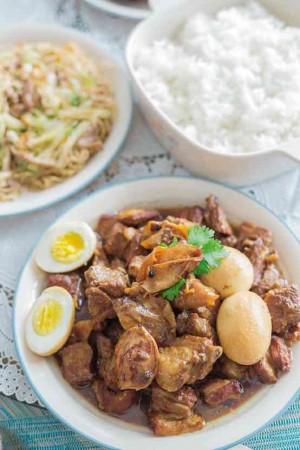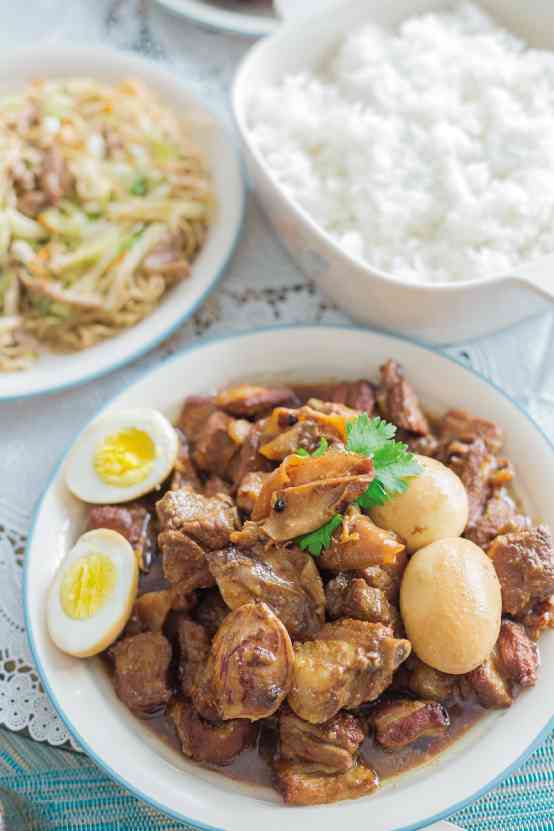
No one can fault Jane Uy Lim if she likes her adobo sweeter than the usual salty-sour finish. She adds a good amount of sugar to the traditional garlic-vinegar-pepper-and-soy sauce stew.
While other cooks put something extra into the dish, such as chicken liver, potatoes, coconut milk, bagoong and even foie gras, Lim savors her pork adobo with dried squid.
The inclusion of dried squid also yields a nice relish, giving the dish a real heady, sweet flavor. The sweetness overpowers the sourness of the vinegar but nevertheless balances the peppery taste.
Lim reduces the amount of soy sauce and other liquids until the tasty dark oil from the meat comes out and makes a delicious topping on a mound of rice. The dried squid becomes the star of the show that also provides a lovely chewy texture.
To make it more special, she serves the adobo with slices of hard-boiled eggs.
“I grew up with this kind of adobo, nothing else,” says Lim, 57. “For my family, it’s not going to be a good adobo if there are no pieces of pusit (squid) in it.”
The original recipe came from Lim’s maternal grandmother. Of Chinese descent, Lim grew up with her lola in Bacolod and she would spend most of her time helping her in the kitchen.
“I would always bug her about certain dishes, how it must be prepared and what ingredients went into it,” says Lim, a mother of five.
Cooking and baking
When she tried her hand at cooking, she started selling Christmas hams to relatives and friends back in the 1970s. Then she moved to making moon cakes. Eventually, she dabbled in baking which she found more fulfilling. She started with brownies and banana cake.
Now Lim is known for her ensaymada, cheese cupcake, asado bread and many more.
To sharpen her skills, she attended cooking and baking lessons by Reggie Aspiras and Dorothy Ferreria and short classes at the International School for Culinary Arts and Hotel Management.
Like other seasoned cooks, Lim hardly measures her recipes. She simply dumps everything in the pan and adjusts the seasoning accordingly.
“Just by smelling the dish you’d know if it’s thoroughly cooked or not,” she says.
Lim prefers to use spareribs, which has leaner flesh, than liempo (pork belly).
“We don’t like to eat the pork skin,” she says. Lim buys dried squid in Divisoria. A kilo of dried squid costs P600.
Lim’s children and grandchildren also like her crispy pork with Chinese sweet and sour sauce, chicken wings in garlic soy, patatim, sotanghon, chicken relleno meat loaf, roast chicken marinated in soda and pot roast beef.
“But, nothing beats adobo as the family’s comfort food,” says Lim.

Pork Adobo with Dried Squid
1 k pork spareribs
¼ c sugar
1 tbsp cane vinegar
1 tbsp whole peppercorn
1 1/8 c water from the soaked squid
1 head garlic, peeled and crushed
¼ c soy sauce
5 or 6 pieces of dried squid (small)
hard-boiled egg (optional)
Wash dried squid in running water. Soak squid in two cups of water for 10-15 minutes. Remove squid and save the water.
Put all ingredients in a pan except for the dried squid. Let it boil and lower heat. Stir. Add the dried squid. Allow to boil again. Simmer until the pork is tender. Add boiled egg. Season to taste (either more sugar or soy sauce).
E-mail the author at [email protected]













































